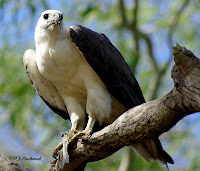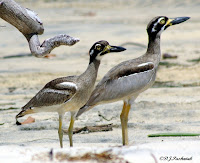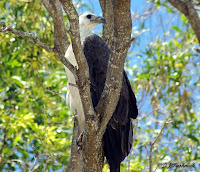Yesterday afternoon I went out to Inskip Point in the late afternoon. A walk through the bush track leading out to the Point is always interesting and this time I got good clear views and photos of White-cheeked Honeyeaters. I find photos interesting because they freeze the bird in poses often very different from the stiff side views found in most birding books. These photos show the white cheeks quite differently from anything in my books.


We had been told that other birders had seen a Kelp Gull here a few days ago. This is a very rare vagrant up here and we hoped that maybe it had stayed around for a few days. We were lucky! I was intent on a large flock of little shorebirds that kept flying in and roosting in the car tracks out on the point but fortunately 'Neil' from
Out and About in Cooloola wandered a bit further on and then beckoned to me to come quickly. The gull was sitting quietly at the edge of the sea - and what was even better it let us walk quite close to get some good photos. It only flew off when a couple of people with a dog running loose came walking along between us and the bird!

The Tern count we did as the sun set and darkness came down was not nearly so interesting. Last time we were out here (2 and a half weeks ago) we counted a little less than 7,000 terns. This time there were less than 2,000. Where had they gone and why?
The sky is always beautiful looking out across the water and this evening it was particularly spectacular as we watched very dark storm clouds moving from east to west some distance south from us.
























 For more bird photographs see the Bird Photography Weekly.
For more bird photographs see the Bird Photography Weekly.
















